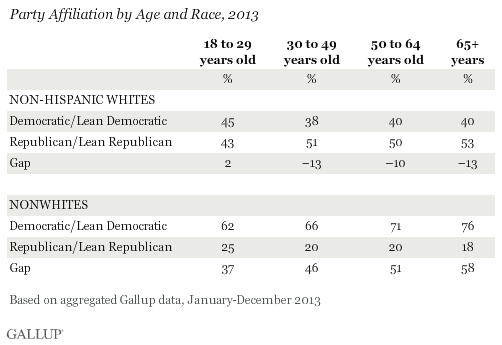Is Racial Polarization In Voting Increasing Or Decreasing?
Well, it all depends on what data you emphasize.
Gallup put out two recent pieces suggesting the answer is: yes. The first demonstrated that, over the course of time, whites as a whole have gotten more Republican, and more reliably so:
In recent years, party preferences have been more polarized than was the case in the 1990s and most of the 2000s. For example, in 2010, nonwhites’ net party identification and leanings showed a 49-point Democratic advantage, and whites were 12 percentage points more Republican than Democratic. The resulting 61-point racial and ethnic gap in party preferences is the largest Gallup has measured in the last 20 years. Since 2008, the racial gaps in party preferences have been 55 points or higher each year; prior to 2008, the gaps reached as high as 55 points only in 1997 and 2000.
The increasing racial polarization in party preferences is evident when comparing the data by presidential administration. Nonwhites’ average party preferences have been quite stable across the last three administrations, consistently showing a roughly 47-point Democratic advantage under Clinton, Bush, and Obama. On average, 69% of nonwhites have identified as Democrats or said they were independents who leaned Democratic, and 21% have identified as Republicans or leaned Republican.
Meanwhile, whites have become increasingly Republican, moving from an average 4.1-point Republican advantage under Clinton to an average 9.5-point advantage under Obama.
And a subsequent piece noted, more specifically, that voters over age 65 have trended strongly toward the Republicans, and identified that trend with the fact that the 65+ group is much whiter than the electorate as a whole:
Gallup’s analysis reveals that the changes in seniors’ party preferences are attributable in part to attitudinal change among today’s seniors as they have aged. This is evident in survey results from 1993 and 2003 that show the party preferences of today’s seniors when they were 10 or 20 years younger.
In 1993, Americans then aged 45 to 79 represented the age group that today is 65 to 99. At that time, 20 years ago, those 45 to 79 were highly Democratic, with a 12-point advantage in favor of the Democrats. That gap was larger than the average seven-point Democratic advantage among younger age groups that year.
Ten years later, all age cohorts had become more Republican and were fairly balanced politically. Today’s seniors, who were aged 55 to 89 in 2003, were the only age cohort to tilt Democratic at that time. The 2013 results show that today’s seniors have continued to move in a Republican direction, while the younger age cohorts have gone back in a Democratic direction.
U.S. party preferences are strongly polarized along racial lines, and one reason seniors are more Republican now is that they are racially distinct from other age groups. Eighty-five percent of those 65 and older are non-Hispanic whites, according to Gallup estimates, compared with 77% of 50- to 64-year-olds, 66% of 30- to 49-year-olds, and 54% of 18- to 29-year-olds.
So: whites are trending Republican, and seniors are trending Republican, and those two groups overlap substantially, all of which is driving increasing racial polarization in voting.
But there’s another way to slice the same data from Gallup:
Across different age cohorts, whites show something like a 12-point advantage for Republicans – except for the youngest cohort of white voters, which shows a 2-point advantage for the Democrats. Meanwhile, across all age cohorts non-white voters show a marked preference for the Democratic Party. But that advantage shrinks with every cohort: from a 58-point Democratic advantage among non-white seniors, to a mere 37-point advantage among the youngest non-white cohort.
In other words: white Democrats and non-white Republicans both skew young relative to their racially-similar counterparts of the opposite party. That suggests a possible counter-narrative, whereby racial polarization in voting is actually weakening over time.
Here’s a possible way to reconcile both readings of the data. Racial solidarity is a more substantial vote-motivator for older Americans than for younger Americans – both for white and non-white groups. Assuming that currently-young voters don’t grow more racially-motivated over time, that means that, over time, the electorate as a whole will be less-motivated by racial solidarity in voting. However, in the Obama era, the racial identity of each party has become more sharply defined in voters’ minds, with the Republicans being understood as the white-identified party and the Democrats being identified as the non-white-identified party. The latter effect dominated over the former in the Obama era, resulting in a higher degree of racial polarization in voting. But the weaker identification of young voters, white and non-white, with the party that “represents” them racially, suggests that this polarization could be temporary, and could be quickly reversed if events weakened the racial identity of either or both parties in a future election.

Comments